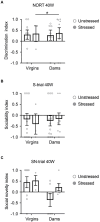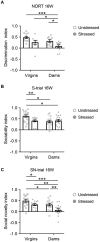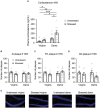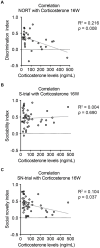Adolescent stress accelerates postpartum novelty recognition impairment in 5xFAD mice
- PMID: 38812977
- PMCID: PMC11133596
- DOI: 10.3389/fnins.2024.1366199
Adolescent stress accelerates postpartum novelty recognition impairment in 5xFAD mice
Abstract
Pregnancy and the postpartum period induce physiological changes that can influence women's cognitive functions. Alzheimer's disease (AD) has a higher prevalence in women and is exacerbated by early life stress. In the present study, we found that late adolescent social isolation combined with the experience of pregnancy and delivery accelerates the onset of cognitive deficits in 5xFAD dams, particularly affecting their ability to recognize novelty. These cognitive deficits manifested as early as 16 weeks, earlier than the usual timeline for these mice, and were closely associated with increased levels of corticosterone, suggesting dysregulation of the hypothalamic-pituitary-adrenal (HPA) axis. Notably, the presence of β-amyloid plaques in brain regions associated with novelty recognition did not significantly contribute to these deficits. This highlights the potential role of stress and HPA axis dysregulation in the development of cognitive impairments related to AD, and underscores the need for further investigation.
Keywords: Alzheimer’s disease; acceleration; adolescent stress; corticosterone; novelty recognition impairment.
Copyright © 2024 Leitzel, Francis-Oliveira, Khedr, Ariste, Robel, Kano, Arrant and Niwa.
Conflict of interest statement
The authors declare that the research was conducted in the absence of any commercial or financial relationships that could be construed as a potential conflict of interest.
Figures





Similar articles
-
Gestational Stress Augments Postpartum β-Amyloid Pathology and Cognitive Decline in a Mouse Model of Alzheimer's Disease.Cereb Cortex. 2019 Aug 14;29(9):3712-3724. doi: 10.1093/cercor/bhy251. Cereb Cortex. 2019. PMID: 30561536 Free PMC article.
-
Prenatal noise stress aggravates cognitive decline and the onset and progression of beta amyloid pathology in a mouse model of Alzheimer's disease.Neurobiol Aging. 2019 May;77:66-86. doi: 10.1016/j.neurobiolaging.2019.01.019. Epub 2019 Jan 30. Neurobiol Aging. 2019. PMID: 30784814
-
Inability to suppress the stress-induced activation of the HPA axis during the peripartum period engenders deficits in postpartum behaviors in mice.Psychoneuroendocrinology. 2018 Apr;90:182-193. doi: 10.1016/j.psyneuen.2017.12.003. Epub 2017 Dec 21. Psychoneuroendocrinology. 2018. PMID: 29274662 Free PMC article.
-
The stress system in the human brain in depression and neurodegeneration.Ageing Res Rev. 2005 May;4(2):141-94. doi: 10.1016/j.arr.2005.03.003. Ageing Res Rev. 2005. PMID: 15996533 Review.
-
Role of Hypothalamic-Pituitary-Adrenal Axis, Hypothalamic-Pituitary-Gonadal Axis and Insulin Signaling in the Pathophysiology of Alzheimer's Disease.Neuropsychobiology. 2019;77(4):197-205. doi: 10.1159/000495521. Epub 2019 Jan 3. Neuropsychobiology. 2019. PMID: 30605907 Review.
Cited by
-
Arhgef7 as a key target for enriched environment rescuing spatial cognitive deficits and anxiety-like behaviors in a mouse model of Alzheimer's disease following early social isolation.Alzheimers Res Ther. 2025 Jul 1;17(1):143. doi: 10.1186/s13195-025-01797-5. Alzheimers Res Ther. 2025. PMID: 40598577 Free PMC article.
References
Grants and funding
LinkOut - more resources
Full Text Sources
Molecular Biology Databases

